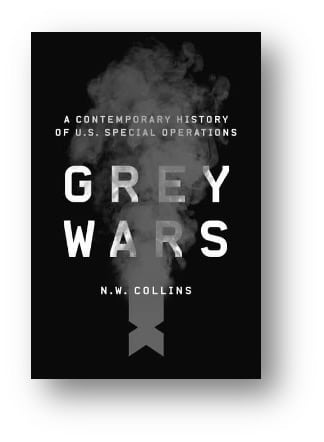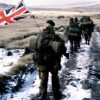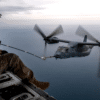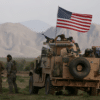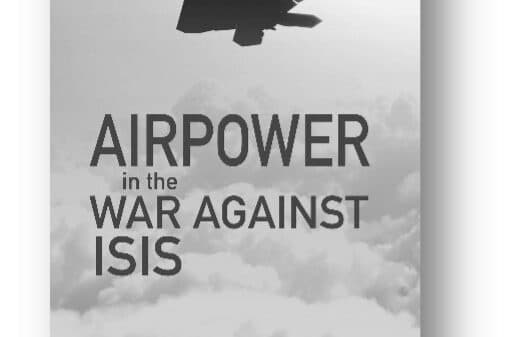ISBN 9780300198416, Yale University Press, June 2021, 320 pages, $28.00
Reviewed by: Angelica Vallario, Harvard University Extension School, Cambridge, Massachusetts, USA
N.W. Collins defines grey wars as “not large-scale wars of annihilation, of steel on steel. Instead, [they] are marked by protracted and persistent struggles, without a beginning and an end, without a victor and a vanquished.” They take place in the “grey areas” of the map, not against industrialized countries’ militaries, but against subversives, insurgents, guerrillas in locations without infrastructure. These locations provide places to hide and grow, where they can fight according to their own playbook. The problem is getting global strategy to shift focus from the Cold War Era industrialized zones and focus on these “grey areas” that “maybe … aren’t so dark after all.” In Collins’ addition to the world of special operations literature, Grey Wars: A Contemporary History of U.S. Special Operations, she weaves her background in U.S. defense and military technology with an extensive primary and secondary source list full of interviews, news articles, an array of books in the field, and military documents. She uses these to map out how the United States Special Operations Command (USSOCOM), in support of the geographic combatant commands, fought “the grey wars” over the last five decades amidst an ever-evolving threat. Collins argues that the way Special Operations Forces (SOF) strategically approach insurgents and those acting within the “grey areas” has not necessarily changed post-9/11, the public perception of grey wars has changed based on an increasing speed and access to the release of information as technology progresses.
The first half of the book alternates between a 9/11 Coalition Warfare Research trip Collins took to MacDill Air Force Base in 2010 to learn about the workings of USSOCOM and U.S. Central Command with the events from the late 1970s to the 1990s that led up to the creation of these institutions and their specific goals. After the failure of a joint special operation during the Iran Hostage Crisis, public policy driven by safety requirements necessitated the creation of USSOCOM. USSOCOM is tasked with combating global terrorism through unconventional operations, foreign military training, and crisis missions, by working in the so-called “grey area.” During the restructuring of special operations because of Congressional oversight to deal with the problems that came to light in Iran and questions regarding how large their role should be, Collins points out that al-Qaeda and Osama bin Laden acted on what they saw as “U.S. impotence” and began building into a concerning threat that culminated in the 9/11 terrorist attacks. This “crisis [acted] as a catalyst” leading to a sizeable increase in USSOCOM’s personnel, budget, and deployments.
With the 2002 Authorization for the Use of Military Force, the U.S. would call upon the core competencies of special operations (namely their quick reaction time) making them the first military entrants into Afghanistan in this new “long war, from everlasting waged” that eventually would span decades and many other countries. Special Forces operators would adapt the “Lawrence Method” laid out in the Seven Pillars of Wisdom acting as “nation builders as well as warriors … [helping to] re-establish institutions and local security forces … [assisting] in the rebuilding of infrastructure and basic services … [facilitating] the establishment of local governance and the rule of law” in their attempts to root out terrorism in the Middle East.
The bin Laden raid is the turning point in the book that mirrors what Collins lays out as a defining moment in public interest in special operations, thrusting them into the media with a certain level of star power most are uncomfortable with. As former USSOCOM Commander, William McRaven put it, “it was a standard raid and not really very sexy.” The certain level of “star power” that came because of this event would overshadow coverage of a downed helicopter, Extortion 17, that killed thirty-eight a few months later, but unlike previous failures would not result in a questioning of special operations abilities. They would continue to be integral to U.S. strategy in the fight with the Islamic State of Iraq and Syria in the late 2010s. With the withdrawal from Afghanistan in 2021, Collins’ claim of an unknown future seems to ring true but may miss the mark because it is inconclusive in a time of uncertainty. It could have used this opportunity to provoke discussion in applying this grey war methodology to where special operations is heading and whether the creation of USSOCOM improved upon the problems in earlier engagements it had been created to fix. Regardless, Collins’ writing is easily digestible to the reader with an innate understanding of the special operations community. Pulling on her background in military technology, the “tangible instruments of a special operator’s physical battlefield,” each chapter begins with technological imagery (a helicopter made of bolts for Iran, a compass made of knives for Extortion 17, and a target puzzle piece for the coalition). Each image stands as a thought-provoking representation of the chapter’s message. The writing also provides a level of detail focusing on space, specifically items in relation to each other, reading almost as a sort of map of special operations and its inner workings. Though Collins acknowledges “a lot is missing from the book—deliberately,” beyond a brief mention, it may have benefited from a differentiation between the special operations commands (i.e., Joint Special Operations Command, U.S. Army Special Operations Command [USASOC], Air Force Special Operations Command, U.S. Marine Forces Special Operations Command, and U.S. Naval Special Warfare Command [NAVSPECWARCOM] and their identified capabilities. Though their overall missions may overlap, they can be decidedly different in terms of direct action, unconventional warfare, and foreign internal defense. Their unique mission requirements allow them to be tasked by USSOCOM to do different things in responding to these “grey areas.” For example: USASOC, created in 1989, includes not only the Green Berets, who use their language and cultural skills to carry out their nine principal tasks including specifically unconventional warfare and coalition warfare/support, but also Civil Affairs Units, who focus on populace/resources control and foreign humanitarian assistance. NAVSPECWARCOM, created in 1987, like USASOC, includes principal tasks such as counterterrorism and unconventional warfare, but their Navy SEALs have a distinct specialization in maritime special operations. Through grouping together, Collins is able to keep the book concise, however, differentiating may have provided the reader with more of a framework towards understanding the connection between the events discussed and the larger policy implications in terms of funding and future use. This is key in looking at what the future potentially holds, amid funding cuts in the USSOCOM community. Overall, Collins succeeds in providing a deeper understanding of the inner workings of how USSOCOM works in approaching and suppressing counterterrorism as it appears within the “grey areas” of the world.
